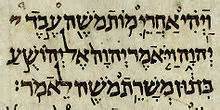"In the Fear of Our God" -- Nehemiah 5:1-13
 Tuesday, December 6, 2016 at 10:15AM
Tuesday, December 6, 2016 at 10:15AM  The Fifteenth in a Series of Sermons on Ezra-Nehemiah
The Fifteenth in a Series of Sermons on Ezra-Nehemiah
Fear and threat of disaster seem to bring out the best or the worst in people. In Nehemiah 4 we read the remarkable account of the people of Israel coming together as one in their collective effort to rebuild the walls of the city of Jerusalem. With a Herculean effort–brought about, in part, by the decisive and capable leadership of Nehemiah–the Jews managed to complete the walls, gates, and fortifications surrounding the entire city. The walls were but half of their eventual height and strength, but the work was done quickly in the face of threat of attack by the chief antagonist of the Book of Nehemiah, a man named Sanballat. Sanballat was a Samaritan and the former governor of Judea. If Sanballat’s threats did not succeed in keeping the Jews from rebuilding their walls, the human toll exacted by the nearly two months of difficult labor in rebuilding the walls leads to the scenario described in chapter 5; the revelation of terrible injustice wrought on the people of Israel by their own brothers, as well as serious shortages of the necessities of life. Out of this very real distress arises a crisis in which the people of God cry out to YHWH and their leaders for relief, a cry which reveals deep troubles within the community of Israel. If chapter 4 is about Israel’s defiant response to an external threat, then chapter 5 is about an even greater threat–the rise of internal dissent within the ranks of Israel.
We are returning to our series on Ezra-Nehemiah after a break of several weeks. Recall from our time in chapter 4, Sanballat heard about the rapid progress the Jews were making in rebuilding their walls and defenses, and tried to stop the Jews through ridicule (which did not work), and then through the threat of attack upon Jerusalem by his own small forces. Sanballat could not attack Jerusalem without the permission of the Persian king Artaxerses, who instead commissioned his own cup-bearer, Nehemiah, to do the job of rebuilding Jerusalem’s walls and gates–not only vital to the city’s defense, but also a major part of the city’s infrastructure. Sanballat used a clever ruse, threatening to invade Jerusalem, hoping that panic would come over the people so that the work of rebuilding would stop, and the Jews would flee the city, leaving Jerusalem in ruins.
It was through Nehemiah’s strong and decisive action that the Jews did not panic and instead prepared for war. Nehemiah had the men work with their construction tools in one hand, and their weapons in the other. He stationed reserve troops to respond quickly to any point of attack. He positioned weapons strategically around the city so that at the first word of attack, the wall-builders could immediately become soldiers. While preparing the people for battle, at the same time, Nehemiah reminded the former exiles that success in battle was assured because YHWH always remembers his covenant promises and fights for his people. Nehemiah’s message to Israel is that you prepare yourselves for battle, but you must trust YHWH to bring about a victorious outcome.
The fact that YHWH fights on behalf of his people directs us to one of the great subplots running throughout all the Bible–Christ (at this point in redemptive history, the promised Messiah) against the Antichrist, those human agents of Satan who seek to thwart God’s purposes, thereby delaying or preventing the coming of the Messiah. Satan attempts this disruption by using two preferred tactics: external force, and/or internal strife or deception. We see the first method used by Satan come into play with the threats made by Sanballat aimed toward stopping the rebuilding of the city’s walls and infrastructure. Sanballat is doing this for purely personal reasons. He’s mad that Nehemiah has replaced him as governor, and as a Samaritan, he believes the Jews are apostates, and the true temple of God is on Mount Gerazim (in Samaria), not Mount Zion. So even though he has his own personal reasons to oppose the rebuilding of Jerusalem, his actions (along with Tobias, his lackey, and Geshem [i.e., Chunky]) ultimately serve the purposes of Antichrist. If the Israelites flee, the walls of Jerusalem are not rebuilt, the city will remain in ruins, and more importantly, the sacrifices and offerings made by the priests in the temple will cease, or be seriously compromised. This is Satan’s ultimate purpose.
To read the rest of this sermon, Click Here








